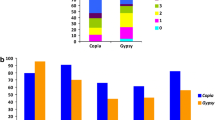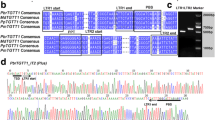Abstract
Availability of genome sequence of different legume species has provided an opportunity to characterize the abundance, distribution, and divergence of canonical intact long terminal retrotransposons (In-LTR-RT) superfamilies. Among seven legume species, Arachis ipaensis (Aip) showed the highest number of full-length canonical In-LTR-RTs (3325), followed by Glycine max (Gma, 2328), Vigna angularis (Van, 1625), Arachis durensis (Adu, 1348), Lotus japonicus (Lja, 1294), Medicago truncatula (Mtr, 788), and Circer arietinum (Car, 124). Divergence time analysis demonstrated that the amplification timeframe of LTR-RTs dramatically varied in different families. The average insertion time of Copia element varied from 0.51 (Van) to 1.37 million years ago (Mya) (Adu, and Aip), whereas that of Gypsy was between 0.22 (Mtr) and 1.82 Mya (Adu). Bayesian phylogenetic tree analysis suggested that the 1397 and 1917 reverse transcriptase (RT) domains of Copia and Gypsy families of the seven legume species were clustered into 7 and 14 major groups, respectively. The highest proportion (approximately 94.79–100%) of transposable element (TE)-associated genes assigned to pathways was mapped to metabolism-related pathways in all species. The results enabled the structural understanding of full-length In-LTR-RTs and will be valuable resource for the further study of the impact of TEs on gene structure and expression in legume species.







Similar content being viewed by others
References
Arabidopsis Genome I (2000) Analysis of the genome sequence of the flowering plant Arabidopsis thaliana. Nature 408:796–815
Barghini E, Natali L, Giordani T, Cossu RM, Scalabrin S, Cattonaro F, Imkova H, Vrana J, Dole el J, Morgante M, Cavallini A (2015) LTR retrotransposon dynamics in the evolution of the olive (Olea europaea) genome. DNA Res 22(1):91–100
Baucom RS, Estill JC, Chaparro C, Upshaw N, Jogi A, Deragon JM et al (2009) Exceptional diversity, non-random distribution, and rapid evolution of retroelements in the B73 maize genome. PLoS Genet 5:e1000732
Bertioli DJ, Cannon SB, Froenicke L, Huang G, Farmer AD, Cannon EK et al (2016) The genome sequences of Arachis duranensis and Arachis ipaensis, the diploid ancestors of cultivated peanut. Nat Genet 48:438–446
Conesa A, Gotz S (2008) Blast2GO: a comprehensive suite for functional analysis in plant genomics. Int J Plant Genom 2008:619832
Dash S, Cannon E et al (2016) PeanutBase and other bioinformatic resources for peanut (chapter 8). In: Thomas Stalker H, Wilson RF (eds) Peanuts genetics, processing, and utilization. AOCS Press, Urbana, pp 241–252
Du J, Tian Z, Hans CS, Laten HM, Cannon SB, Jackson SA et al (2010) Evolutionary conservation, diversity and specificity of LTR-retrotransposons in flowering plants: insights from genome-wide analysis and multi-specific comparison. Plant J 63:584–598
Eckardt NA (2000) Sequencing the rice genome. Plant Cell 12:2011–2017
Eddy SR (2009) A new generation of homology search tools based on probabilistic inference. Genome Inform 23:205–211
Eddy SR (2011) Accelerated profile HMM searches. PLoS Comput Biol 7:e1002195
El-Gebali S, Mistry J, Bateman A, Eddy SR, Luciani A, Potter SC et al (2019) The Pfam protein families database in 2019. Nucleic Acids Res 47:D427–D432
Ferreira de Carvalho J, de Jager V, van Gurp TP, Wagemaker NC, Verhoeven KJ (2016) Recent and dynamic transposable elements contribute to genomic divergence under asexuality. BMC Genom 17:884
Feschotte C, Pritham EJ (2007) DNA transposons and the evolution of eukaryotic genomes. Annu Rev Genet 41:331–368
Flavell RB (1986) Repetitive DNA and chromosome evolution in plants. Philos Trans R Soc Lond B Biol Sci 312(1154):227–242
Gao D, Jiang N, Wing RA, Jiang J, Jackson SA (2015) Transposons play an important role in the evolution and diversification of centromeres among closely related species. Front Plant Sci 6:216
Gaut BS, Morton BR, McCaig BC, Clegg MT (1996) Substitution rate comparisons between grasses and palms: synonymous rate differences at the nuclear gene Adh parallel rate differences at the plastid gene rbcL. Proc Natl Acad Sci USA 93:10274–10279
Hollister JD, Smith LM, Guo YL, Ott F, Weigel D, Gaut BS (2011) Transposable elements and small RNAs contribute to gene expression divergence between Arabidopsis thaliana and Arabidopsis lyrata. Proc Natl Acad Sci USA 108(6):2322–2327
Horvath R, Slotte T (2017) The role of small RNA-based epigenetic silencing for purifying selection on transposable elements in Capsella grandiflora. Genome Biol Evol 9(10):2911–2920
Hribová E, Neumann P, Matsumoto T, Roux N, Macas J, Dolezel J (2010) Repetitive part of the banana (Musa acuminata) genome investigated by low-depth 454 sequencing. BMC Plant Biol 10:204
Hu G, Hawkins JS, Grover CE, Wendel JF (2010) The history and disposition of transposable elements in polyploid Gossypium. Genome 53(8):599–607
Hu TT, Pattyn P, Bakker EG, Cao J, Cheng JF et al (2011) The Arabidopsis lyrata genome sequence and thebasis of rapid genome size change. Nat Genet 43(5):476–481
Jain M, Misra G, Patel RK, Priya P, Jhanwar S, Khan AW, Shah N, Singh VK, Garg R, Jeena G, Yadav M, Kant C, Sharma P, Yadav G, Bhatia S, Tyagi AK, Chattopadhyay D (2013) A draft genome sequence of the pulse crop chickpea (Cicer arietinum L.). Plant J 74(5):715–729
Jayaswal PK, Shanker A, Singh NK (2019). Genome-wide comparative and evolutionary analysis of transposable element of eight legume plants. Indian J Agric Sci. Accepted 12 Sep 2019
Kang YJ, Satyawan D, Shim S, Lee T, Lee J, Hwang WJ et al (2015) Draft genome sequence of adzuki bean, Vigna angularis. Sci Rep 5:8069
Katoh K, Asimenos G, Toh H (2009) Multiple alignment of DNA sequences with MAFFT. Methods Mol Biol 537:39–64
Kipling D, Warburton PE (1997) Centromeres, CENP-B and Tigger too. Trends Genet 13:141–145. https://doi.org/10.1016/S0168-9525(97)01098-6
Lu Q, Li H, Hong Y, Zhang G, Wen S et al (2018) Genome sequencing and analysis of the peanut B-genome progenitor (Arachis ipaensis). Front Plant Sci 9:604
Ma J, Bennetzen JL (2004) Rapid recent growth and divergence of rice nuclear genomes. Proc Natl Acad Sci USA 101:12404–12410
Ma J, Jackson SA (2006) Retrotransposon accumulation and satellite amplification mediated by segmental duplication facilitate centromere expansion in rice. Genome Res 16(2):251–259
Ma B, Kuang L, Xin Y, He N (2019) New insights into long terminal repeat retrotransposons in mulberry species. Genes 10(4):285
Makarevitch I, Waters AJ, West PT, Stitzer M, Hirsch CN, Ross-Ibarra J et al (2015) Transposable elements contribute to activation of maize genes in response to abiotic stress. PLoS Genet 11:e1004915
Mascagni F, Giordani T, Ceccarelli M, Cavallini A, Natali L (2017) Genome-wide analysis of LTR-retrotransposon diversity and its impact on the evolution of the genus Helianthus (L.). BMC Genom 18(1):634. https://doi.org/10.1186/s12864-017-4050-6
Nagarajan N, Navajas-Pérez R, Pop M, Alam M, Ming R, Paterson AH, Salzberg SL (2008) Genome-wide analysis of repetitive elements in papaya. Trop Plant Biol 1:191–201
Nussbaumer T, Martis MM, Roessner SK, Pfeifer M, Bader KC, Sharma S et al (2013) MIPS PlantsDB: a database framework for comparative plant genome research. Nucleic Acids Res 41:D1144–D1151
Ou S, Jiang N (2018) LTR_retriever: a highly accurate and sensitive program for identification of long terminal repeat retrotransposons. Plant Physiol 176(2):1410–1422. https://doi.org/10.1104/pp.17.01310
Paterson AH, Bowers JE, Bruggmann R, Dubchak I, Grimwood J, Gundlach H et al (2009) The Sorghum bicolor genome and the diversification of grasses. Nature 457:551–556
Piegu B, Bire S, Arensburger P, Bigot Y (2015) A survey of transposable element classification systems–a call for a fundamental update to meet the challenge of their diversity and complexity. Mol Phylogenet Evol 86:90–109
Rayburn AL, Biradar DP, Bullock DG, McMurphy LM (1993) Nuclear DNA content in F1 hybrids of maize. Heredity 70:294–300
Ronquist F, Huelsenbeck JP (2003) MrBayes 3: Bayesian phylogenetic inference under mixed models. Bioinformatics 19:1572–1574
Rossi M, Araujo P, Sluys MV (2001) Survey of transposable elements in sugarcane expressed sequence tags (ESTs). Genet Mol Biol 24(1–4):141–146
Sarkar D, Mahato AK, Satya P, Kundu A, Singh S, Jayaswal PK et al (2017) The draft genome of Corchorus olitorius cv. JRO-524 (Navin). Genom Data 12:151–154
Sato S, Nakamura Y, Kaneko T, Asamizu E, Kato T, Nakao M et al (2008) Genome structure of the legume, Lotus japonicus. DNA Res 15:227–239
Schmutz J, Cannon SB, Schlueter J, Ma J, Mitros T, Nelson W et al (2010) Genome sequence of the palaeopolyploid soybean. Nature 463:178–183
Schnable PS, Ware D, Fulton RS, Stein JC, Wei F, Pasternak S et al (2009) The B73 maize genome: complexity, diversity, and dynamics. Science 326:1112–1115
Severin AJ, Cannon SB, Graham MM, Grant D, Shoemaker RC (2011) Changes in twelve homoelogous genomic regions in soybean following three rounds of polyploidy. Plant Cell 23:3129–3136
Shockley FW, Backus EA, Ellersieck MR, Johnson DW, McCaslin M (2002) Glandular-haired alfalfa resistance to potato leafhopper (Homoptera: Cicadellidae) and hopperburn: development of resistance indices. J Econ Entomol 95:437–447
Singh NK, Gupta DK, Jayaswal PK, Mahato AK, Dutta S, Singh S et al (2012) The first draft of the pigeonpea genome sequence. J Plant Biochem Biotechnol 21:98–112
Solovyev V, Kosarev P, Seledsov I, Vorobyev D (2006) Automatic annotation of eukaryotic genes, pseudogenes and promoters. Genome Biol 7(Suppl 1):S10
Swigonova Z, Bennetzen JL, Messing J (2005) Structure and evolution of the r/b chromosomal regions in rice, maize and sorghum. Genetics 169:891–906
Tissier A (2012) Glandular trichomes: what comes after expressed sequence tags? Plant J 70:51–68
Varshney RK, Song C, Saxena RK, Azam S, Yu S, Sharpe AG et al (2013) Draft genome sequence of chickpea (Cicer arietinum) provides a resource for trait improvement. Nat Biotechnol 31:240–246
Velasco R, Zharkikh A, Affourtit J, Dhingra A, Cestaro A, Kalyanaraman A et al (2010) The genome of the domesticated apple (Malus x domestica Borkh.). Nat Genet 42:833–839
Vitte C, Panaud O, Quesneville H (2007) LTR retrotransposons in rice (Oryza sativa, L.): recent burst amplifications followed by rapid DNA loss. BMC Genom 8:218
Wang H, Liu JS (2008) LTR retrotransposon landscape in Medicago truncatula: more rapid removal than in rice. BMC Genom 9:382
Wicker T, Keller B (2007) Genome-wide comparative analysis of copia retrotransposons in Triticeae, rice, and Arabidopsis reveals conserved ancient evolutionary lineages and distinct dynamics of individual copia families. Genome Res 17:1072–1081
Wicker T, Sabot F, Hua-Van A, Bennetzen JL, Capy P, Chalhoub B et al (2007) A unified classification system for eukaryotic transposable elements. Nat Rev Genet 8:973–982
Wicker T, Gundlach H, Spannagl M, Uauy C, Borrill P, Ramirez-Gonzalez RH et al (2018) Impact of transposable elements on genome structure and evolution in bread wheat. Genome Biol 19:103
Xu Y, Du J (2014) Young but not relatively old retrotransposons are preferentially located in gene-rich euchromatic regions in tomato (Solanum lycopersicum) plants. Plant J 80:582–591
Xu Z, Wang H (2007) LTR_FINDER: an efficient tool for the prediction of full-length LTR retrotransposons. Nucleic Acids Res 35(Web Server issue):W265–W268
Yin H, Du J, Wu J, Wei S, Xu Y, Tao S et al (2015) Genome-wide annotation and comparative analysis of long terminal repeat retrotransposons between pear species of P. bretschneideri and P. Communis. Sci Rep 5:17644
Young ND, Debelle F, Oldroyd GE, Geurts R, Cannon SB, Udvardi MK et al (2011) The Medicago genome provides insight into the evolution of rhizobial symbioses. Nature 480:520–524
Acknowledgements
The financial assistance received from the Indian council for Agriculture Research (ICAR) for Network Project on Transgenic in Crops (NPTC) and ICAR- National Professor, B. P. Pal Chair is gratefully acknowledged.
Author information
Authors and Affiliations
Corresponding author
Additional information
Publisher's Note
Springer Nature remains neutral with regard to jurisdictional claims in published maps and institutional affiliations.
Electronic supplementary material
Below is the link to the electronic supplementary material.
Rights and permissions
About this article
Cite this article
Jayaswal, P.K., Shanker, A. & Singh, N.K. Genome wide annotation and characterization of young, intact long terminal repeat retrotransposons (In-LTR-RTs) of seven legume species. Genetica 148, 253–268 (2020). https://doi.org/10.1007/s10709-020-00103-5
Received:
Accepted:
Published:
Issue Date:
DOI: https://doi.org/10.1007/s10709-020-00103-5




